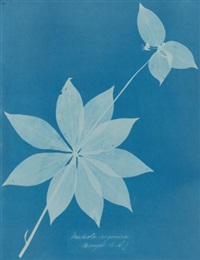Anna Atkins
Anna Atkins was a British photographer and botanist credited with establishing photography as a valid medium for scientific documentation. Born on March 16, 1799 in Tonbridge, United Kingdom, she learned about the new medium of photography through correspondence with its inventor, William Henry Fox Talbot. For her own practice, she used the cyanotype printing method taught to her by its inventor,Sir John Herschel, a family friend. This process allowed Atkins to place her specimens directly on top of light-sensitive paper, which turns blue once developed. She captured the silhouettes of ferns, flowers, feathers, and most famously, algae,self-publishing her prints in Photographs of British Algae in 1843. She produced three volumes on the subject between 1843 and 1853, and collaborated on several other publications of botanical cyanotype photograms. Atkins died on June 9, 1871 in Halstead Place, United Kingdom, and is remembered as the first woman photographer. Notably, on her 216th birthday,Google paid tribute to the artist by including an identifiable blue background and white, leaf-shaped imprint on its search page. Atkins’ photograms are in the collections of the British Library in London, British Museum in London, and the Metropolitan Museum of Art in New York,among others. In 2017, her work was a major feature in the Rijksmuseum of Amsterdam’s retrospective of19th-century photography, “New Realities. Photography in the Nineteenth Century.”
Source: https://www.artnet.com/artists/anna-atkins/
- Anna Atkins(née Children; 16 March 1799–9 June 1871 was an English botanist and photographer. She is often considered the first person to publish a book illustrated with photographic images. Some sources say that she was the first woman to create a photograph. Early life Atkins was born in Tonbridge, Kent, England in 1799. Her mother, Hester Anne Children, “didn’t recover from the effects of childbirth” and died in 1800.[5]Anna was close to her father John George Children, a renowned chemist, mineralogist, and zoologist.[7]Anna “received an unusually scientific education for a woman of her time.”[8]Her detailed engravings of shells were used to illustrate her father’s translation of Lamarck’s Genera of Shells.[8][9]In 1825, she married John Pelly Atkins, a London West India merchant, later sheriff, and proponent of railways; during this same year, she moved to Halstead Place, the Atkins family home in Halstead, near Sevenoaks, Kent.[8][10]They had no children.[11]Atkins pursued her interests in botany by collecting dried plants, which were probably used as photograms later.[8]She was elected a member of the London Botanical Society in 1839.[12]Photography[edit]John George Children and John Pelly Atkins were friends of William Henry Fox Talbot.[8]Anna Atkins learned directly from Talbot about two of his inventions related to photography: the”photogenic drawing” technique (in which an object is placed on light-sensitized paper and exposed to the sun to produce an image) and calotypes.[13][14]Atkins was known to have had access to a camera by 1841.[8]Some sources say that Atkins was the first female photographer,[3][4][5][6][15]while others attribute this title to Constance Fox Talbot.[16][17][18]As no camera-based photographs by Anna Atkins,[8]nor photographs by Constance Talbot,[17]survive, the issue may never be resolved.Photographs of British Algae: Cyanotype Impressions Sir John Herschel, a friend of Atkins and Children, invented the cyanotype photographic process in 1842.[1]Within a year, Atkins applied the process to algae(specifically,seaweed) by making cyanotype photograms that were contact printed[1]”by placing the unmounted dried-algae original directly on the cyanotype paper”.[5]Atkins self-published her photograms in the first installment of Photographs of British Algae: Cyanotype Impressions in October 1843.[2]She planned to provide illustrations to William Henry Harvey’s A Manual of British Algae which had been published in 1841.[19]Although privately published, with a limited number of copies, and with handwritten text, Photographs of British Algae: Cyanotype Impressions is considered the first book illustrated with photographic images.[2][3][4][20]Eight months later, in June 1844, the first fascicle of William Henry Fox Talbot’s The Pencil of Nature was released; that book was the “first photographically illustrated book to be commercially published”[21]or “the first commercially published book illustrated with photographs”.[22]Atkins produced a total of three volumes of Photographs of British Algae: Cyanotype Impressions between 1843 and 1853.[23]Only 17 copies of the book are known to exist, in various states of completeness.[24]Copies are now held by the following institutions, among others:[5][7]


Source: https://www.artnet.com/artists/anna-atkins/
